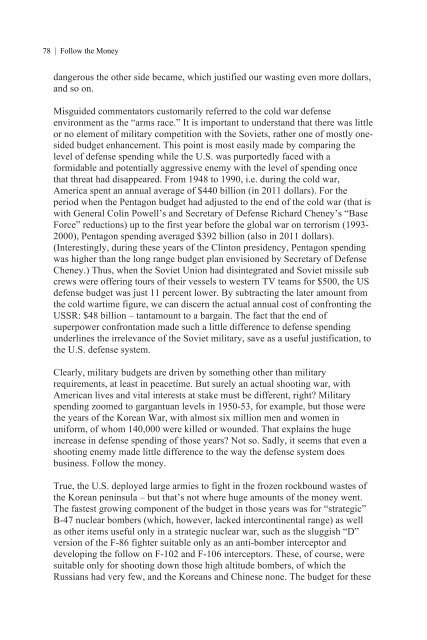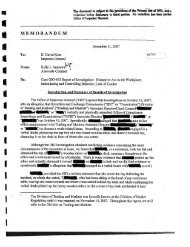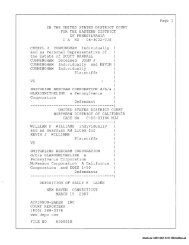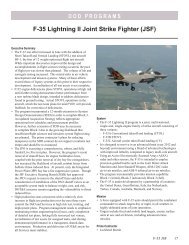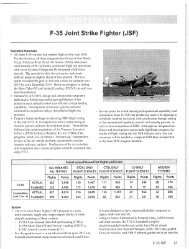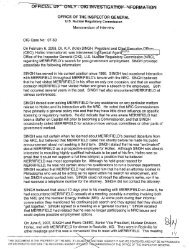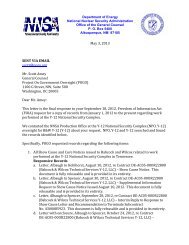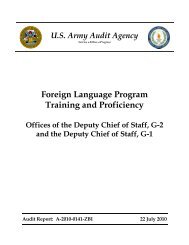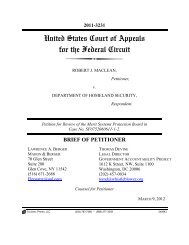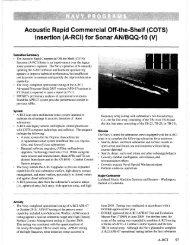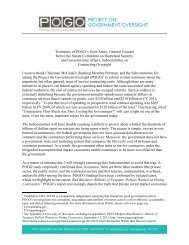The Pentagon Labyrinth
The Pentagon Labyrinth
The Pentagon Labyrinth
Create successful ePaper yourself
Turn your PDF publications into a flip-book with our unique Google optimized e-Paper software.
78 | Follow the Money<br />
dangerous the other side became, which justified our wasting even more dollars,<br />
and so on.<br />
Misguided commentators customarily referred to the cold war defense<br />
environment as the “arms race.” It is important to understand that there was little<br />
or no element of military competition with the Soviets, rather one of mostly onesided<br />
budget enhancement. This point is most easily made by comparing the<br />
level of defense spending while the U.S. was purportedly faced with a<br />
formidable and potentially aggressive enemy with the level of spending once<br />
that threat had disappeared. From 1948 to 1990, i.e. during the cold war,<br />
America spent an annual average of $440 billion (in 2011 dollars). For the<br />
period when the <strong>Pentagon</strong> budget had adjusted to the end of the cold war (that is<br />
with General Colin Powell’s and Secretary of Defense Richard Cheney’s “Base<br />
Force” reductions) up to the first year before the global war on terrorism (1993-<br />
2000), <strong>Pentagon</strong> spending averaged $392 billion (also in 2011 dollars).<br />
(Interestingly, during these years of the Clinton presidency, <strong>Pentagon</strong> spending<br />
was higher than the long range budget plan envisioned by Secretary of Defense<br />
Cheney.) Thus, when the Soviet Union had disintegrated and Soviet missile sub<br />
crews were offering tours of their vessels to western TV teams for $500, the US<br />
defense budget was just 11 percent lower. By subtracting the later amount from<br />
the cold wartime figure, we can discern the actual annual cost of confronting the<br />
USSR: $48 billion – tantamount to a bargain. <strong>The</strong> fact that the end of<br />
superpower confrontation made such a little difference to defense spending<br />
underlines the irrelevance of the Soviet military, save as a useful justification, to<br />
the U.S. defense system.<br />
Clearly, military budgets are driven by something other than military<br />
requirements, at least in peacetime. But surely an actual shooting war, with<br />
American lives and vital interests at stake must be different, right? Military<br />
spending zoomed to gargantuan levels in 1950-53, for example, but those were<br />
the years of the Korean War, with almost six million men and women in<br />
uniform, of whom 140,000 were killed or wounded. That explains the huge<br />
increase in defense spending of those years? Not so. Sadly, it seems that even a<br />
shooting enemy made little difference to the way the defense system does<br />
business. Follow the money.<br />
True, the U.S. deployed large armies to fight in the frozen rockbound wastes of<br />
the Korean peninsula – but that’s not where huge amounts of the money went.<br />
<strong>The</strong> fastest growing component of the budget in those years was for “strategic”<br />
B-47 nuclear bombers (which, however, lacked intercontinental range) as well<br />
as other items useful only in a strategic nuclear war, such as the sluggish “D”<br />
version of the F-86 fighter suitable only as an anti-bomber interceptor and<br />
developing the follow on F-102 and F-106 interceptors. <strong>The</strong>se, of course, were<br />
suitable only for shooting down those high altitude bombers, of which the<br />
Russians had very few, and the Koreans and Chinese none. <strong>The</strong> budget for these


